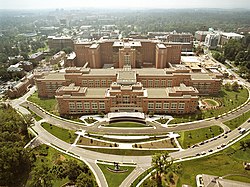
National Institutes of Health
US government medical research agency / From Wikipedia, the free encyclopedia
Dear Wikiwand AI, let's keep it short by simply answering these key questions:
Can you list the top facts and stats about National Institutes of Health?
Summarize this article for a 10 year old
The National Institutes of Health, commonly referred to as NIH, is the primary agency of the United States government responsible for biomedical and public health research. It was founded in the late 1880s and is now part of the United States Department of Health and Human Services. Many NIH facilities are located in Bethesda, Maryland, and other nearby suburbs of the Washington metropolitan area, with other primary facilities in the Research Triangle Park in North Carolina and smaller satellite facilities located around the United States. The NIH conducts its own scientific research through the NIH Intramural Research Program (IRP) and provides major biomedical research funding to non-NIH research facilities through its Extramural Research Program.
 Logo | |
 Aerial photo of the NIH Mark O. Hatfield Clinical Research Center in Bethesda, Maryland | |
| Agency overview | |
|---|---|
| Formed | August 1887; 136 years ago (1887-08) |
| Preceding agency |
|
| Headquarters | Bethesda, Maryland, U.S. 39°00′09″N 77°06′16″W |
| Employees | 18,478 (2021), |
| Annual budget | $45 billion (2022) |
| Agency executive |
|
| Parent agency | Department of Health & Human Services |
| Child agencies | |
| Website | nih.gov |
As of 2013[update], the IRP had 1,200 principal investigators and more than 4,000 postdoctoral fellows in basic, translational, and clinical research, being the largest biomedical research institution in the world,[1] while, as of 2003, the extramural arm provided 28% of biomedical research funding spent annually in the U.S., or about US$26.4 billion.[2]
The NIH comprises 27 separate institutes and centers of different biomedical disciplines and is responsible for many scientific accomplishments, including the discovery of fluoride to prevent tooth decay, the use of lithium to manage bipolar disorder, and the creation of vaccines against hepatitis, Haemophilus influenzae (HIB), and human papillomavirus (HPV).[3]
In 2019, the NIH was ranked number two in the world, behind Harvard University, for biomedical sciences in the Nature Index, which measured the largest contributors to papers published in a subset of leading journals from 2015 to 2018.[4][5] NIH supports Diversity, equity, and inclusion.[6]